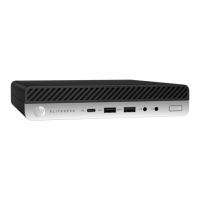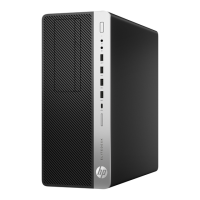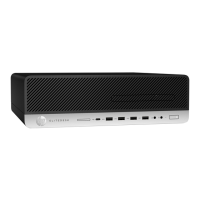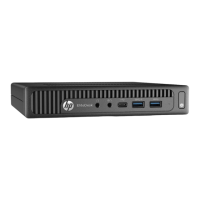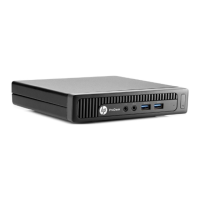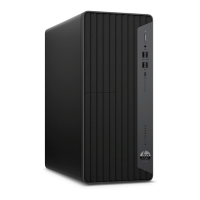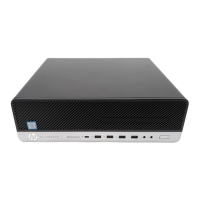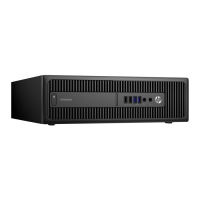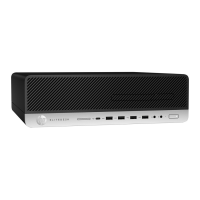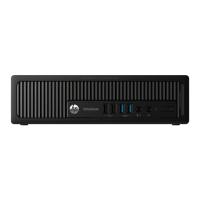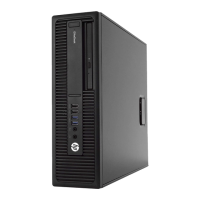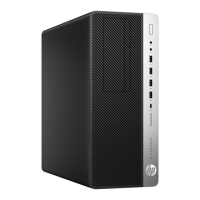
Do you have a question about the HP EliteDesk 800 G3 TWR and is the answer not in the manual?
| Form Factor | Tower |
|---|---|
| Processor Options | Intel Pentium, Intel Celeron |
| Memory | Up to 64 GB DDR4-2400 SDRAM |
| Storage Options | 2.5" HDD/SSD, M.2 SSD |
| Graphics | Intel HD Graphics 630 |
| Operating System | Windows 10 Pro |
| Audio | Realtek HD ALC221-VB Audio |
| Expansion Slots | 1 PCIe x16 |
| Ports (Front) | 2 x USB 3.1 Gen 1, 2 x USB 2.0, 1 x headphone/microphone combo |
| Ports (Rear) | 4 x USB 3.1 Gen 1, 4 x USB 2.0, 1 x VGA, 1 x DisplayPort, 1 x RJ-45, 1 x audio line-out, 1 x audio line-in |
| Power Supply | 250W, up to 92% efficient PSU |
| Optical Drive | Optional DVD-Writer |
| Chipset | Intel® Q270 |
Details the various connectors and indicators located on the front of the computer.
Identifies and describes the ports and connectors on the back of the computer.
Explains where to find the unique serial and product ID numbers for the computer.
Lists major components of the TWR chassis, including bezels, system board, and power supply.
Details various smaller components such as front I/O, sensors, speakers, and card readers.
Catalogues graphics cards, WLAN modules, and various option boards with their ports.
Provides an illustrated list of various cables and adapters used within the computer.
Lists available hard drives, solid-state drives, and optical drives for the system.
Explains the risks of static electricity and how it can damage electronic components.
Provides precautions for handling electrostatic-sensitive parts to prevent damage.
Offers guidelines for setting up a static-free work area for computer maintenance.
Details recommendations for operating the computer to prevent overheating and prolong life.
Lists essential safety rules to follow before cleaning any computer components.
Provides step-by-step instructions for cleaning the computer's exterior casing.
Lists the necessary tools and diagnostic software for servicing the computer.
Outlines initial steps and safety precautions before disassembling the computer.
Instructions on how to remove the computer's access panel to reach internal components.
Procedure for removing and replacing the computer's front bezel.
Detailed steps for removing and installing memory modules (DIMMs) in the system.
Instructions for removing, replacing, or installing expansion cards in PCIe slots.
Procedures for removing and installing various types of drives, including hard drives and optical drives.
Steps for removing and replacing the computer's power supply unit.
Instructions for removing and installing the computer's system board.
Overview of the Computer Setup utility and its capabilities.
Guide on how to access and navigate the Computer Setup menu.
Details system information and configuration options within the Main menu.
Explains security settings, including BIOS administrator password and password policies.
Covers advanced configuration settings for boot options, system options, and port settings.
Instructions for saving and restoring computer configuration settings via removable media.
Provides guidance on establishing a safe and comfortable work environment.
Steps to take to isolate problems before contacting HP support.
Addresses common issues such as system lockups and incorrect date/time.
Diagnoses and resolves issues related to power supply and system power failures.
Troubleshoots issues related to hard disk errors, drive detection, and performance.
Resolves issues with blank screens, distorted images, or display settings.
Diagnoses and fixes issues with sound output, microphone, and headphone functionality.
Addresses issues with keyboard input, mouse responsiveness, and connectivity.
Helps resolve issues when new devices are not recognized or the computer will not start.
Troubleshoots issues with network connectivity, drivers, and controller detection.
Resolves issues related to memory errors, incorrect installation, or insufficient memory.
Fixes issues where USB flash drives are not detected or do not boot.
Addresses issues with application installation, configuration, and driver conflicts.
Lists POST error codes, messages, and their recommended actions.
Explains how to interpret blink and beep codes for system validation diagnostics.
Step-by-step guide to launching the HP PC Hardware Diagnostics tool.
Instructions for downloading and creating a bootable USB drive for diagnostics.
Information on creating recovery media and restoring the system in Windows 10.
Methods for creating system recovery media and data backups.
Guide to using HP Recovery Manager for system recovery and driver reinstallation.
Instructions on how to modify the system's boot device order.
Details on safeguarding information and recovering the system in Windows 7.
Explains how to use Windows recovery tools and f11 recovery for system restoration.
Describes how to recover files, restore points, and use recovery tools.
Instructions for using f11 recovery to restore the original hard drive image.
Instructions for replacing a battery using a Type 1 holder.
Instructions for replacing a battery using a Type 2 holder.
Lists universal requirements for power cord sets, including agency approval and specifications.
Details additional power cord requirements specific to various countries.
Provides steps to restore nonvolatile memory to factory defaults.
Details the types, purpose, and data storage of nonvolatile memory in HP computers.
Presents technical specifications for the TWR chassis, including dimensions and power supply.
